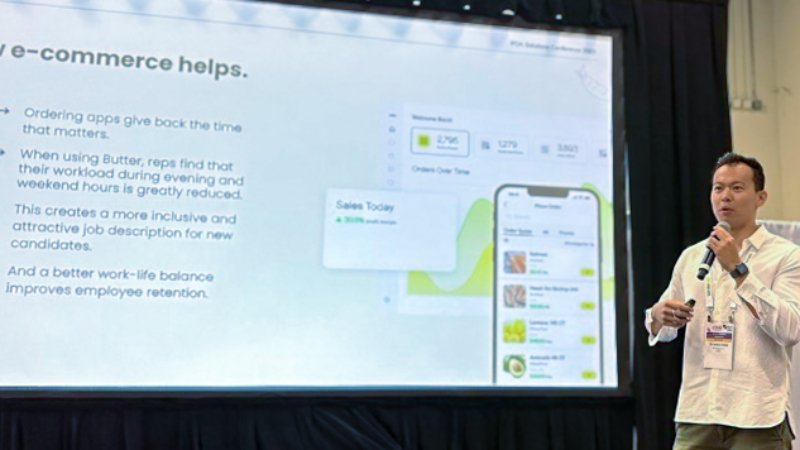
Amidst all the excitement about AI’s transformative potential, one key element is often overlooked: the human factor. While a World Economic Forum report estimates that 40% of workers will need reskilling to adapt to AI, many businesses still assume that technology alone will solve their problems. In reality, AI’s success hinges on a workforce that’s ready and able to use it effectively—requiring significant investment in employee upskilling.
Shangyan Li, Director of AI Product Development from GrubMarket, stresses the importance of workforce readiness in the AI journey: “AI is a tool, but like any tool, it’s only as good as the people using it. Businesses need to approach workforce training with just as much urgency as they do their technology.” This mindset is especially important in industries like food supply chains, where traditional methods of working and legacy systems have persisted for decades.
The Case for Employee-Centric AI Integration
AI promises to revolutionize sectors like logistics, manufacturing, and food distribution, with McKinsey projecting it could contribute as much as a $13 trillion boost to the global economy by 2030. Yet the missing link in many AI rollouts is employee buy-in and readiness. A Pew Research report revealed that more than half of Americans are more concerned than excited about AI—a sentiment which can turn into resistance if employees are not adequately prepared or supported in navigating new AI systems.
GrubMarket, a tech company focused on AI-driven food supply chain management, provides just one example of how thoughtful AI integration can minimize friction. After acquiring Butter, co-founded by Li, GrubMarket introduced GrubAssist AI to streamline existing processes. “We saw early on that there was resistance to change,” Li says. “We had to work alongside clients, spend time on the ground, and show how AI could make their jobs easier—and only then did we start to see things click.” Successful AI tools empower employees by augmenting their existing workflows, making their everyday work easier rather than adding complexity.
But not all AI tools are as seamless. In industries where AI demands significant shifts in the type of work or knowledge it requires—such as integrating predictive analytics or algorithm-based decision-making—rolling out technology without a training program can cause companies to struggle. An Adecco Group survey found that 27% of respondents didn’t believe AI was relevant to their industry at all, despite relying on notoriously inefficient legacy systems and never having explored their options. Platforms like Li’s address this challenge by capturing and incorporating user feedback, helping employees feel like they’re part of the solution while easing the adoption process.
As Li explains, in cases where AI is more disruptive, the key is to offer robust training and feedback loops. “Even when the technology is well-designed,” he notes, “real-world success depends on how well employees are trained to use and trust them. It’s your staff adopting the technology, not your business.”
The Future of Work in AI-Driven Industries
The future of AI in the workplace relies heavily on balancing technological innovation with employee engagement. According to Deloitte, organizations that prioritize employee training are 37% more likely to be able to respond to changing market conditions quickly and effectively. “The idea of ‘AI maturity’ is going to become incredibly important,” Li says. “I think it’s a good turn of phrase, since it captures how the process is about growing the business—your employees—alongside AI.”
While industry giants like Microsoft and Meta have been upskilling employees to work alongside AI tools, more traditional industries are only now catching on. The benefits of AI stretch beyond tech sectors, with applications ranging from predictive farming analytics to smart inventory management in logistics. As global supply chain pressures mount, efficient labor becomes even more critical—and AI can help meet those demands, provided employees are prepared to work alongside it.
The Role of Policy and Regulation
As AI adoption accelerates, U.S. labor policies must keep pace. The National Bureau of Economic Research suggests that AI could increase the productivity of novice and low-skilled workers by up to 34%, but those gains will only be realized if employees are properly trained. Without government-backed reskilling programs, many workers may be left behind, exacerbating existing inequalities.
Li emphasizes the need for collaboration between businesses and policymakers. “We’re entering a period where the pace of technological change is outstripping workforce development,” he says. “We’re past the idea that it’s replacing jobs. Wider legislative support will be necessary to make sure that AI integration benefits everyone—not just those near tech hubs.”
The food industry—worth over $1 trillion in the U.S. alone—serves as a prime example of an industry on the verge of AI-driven transformation. Ensuring workers are equipped to handle these changes is essential for maintaining reliability in the global market.
Making the Most of AI
“You already have great people,” Li says. “And this is about helping them accomplish more.” He emphasizes that momentum builds naturally as employees become familiar with AI, and urges industries to explore their options. After all, training existing workers is far more cost-effective than hiring new talent—by as much as seven times, according to the World Economic Forum.
Ultimately, companies that strike the right balance between technology and training will likely be the ones to benefit most in the AI-powered future of productivity. “We’re forging ahead, and we need to make sure everyone is on board with us,” Li concludes.